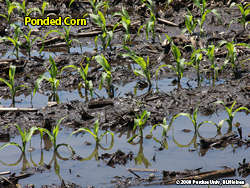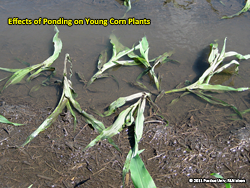Recent intense rainfall events (technically referred to as “toad stranglers” or “goose drownders”) have caused flooding of low-lying corn fields or ponding (standing water) in poorly drained swales within fields. Other areas within fields, while not technically flooded or ponded, may remain saturated for lengthy periods of time.
What are the prospects for recently submerged corn fields or plants simply enduring days and days of saturated soils? The flippant answer is that such suffering crops will survive until they die.
What I mean to say is that no one can tell you with certainty the day after the storm whether a ponded area of a corn field will survive or whether there will be long-term yield consequences until enough time has gone by such that you can assess the actual recovery of the damaged plants. We can, however, talk about the factors that increase or decrease the risks of severe damage or death to flooded soils.
-
Plants that are completely submerged are at higher risk than those that are partially submerged.
- Plants that are only partially submerged may continue to photosynthesize, albeit at limited rates.
-
The longer an area remains ponded, the higher the risk of plant death.
- Most agronomists believe that young corn can survive up to about 4 days of outright ponding if temperatures are relatively cool (mid-60's F or cooler); fewer days if temperatures are warm (mid-70's F or warmer).
- Soil oxygen is depleted within about 48 hours of soil saturation. Without oxygen, the plants cannot perform critical life sustaining functions; e.g. nutrient and water uptake is impaired and root growth is inhibited (Wiebold, 2013).
- Even if surface water subsides quickly, the likelihood of dense surface crusts forming as the soil dries increases the risk of emergence failure for recently planted crops.
|
|
|
|
-
- Be prepared with a rotary hoe to break up the crust and aid emergence.
-
The greater the deposition of mud or old crop residues on plants as the water subsides, the greater the stress on the plants due to reduced photosynthesis.
- Ironically, such situations would benefit from another rainfall event to wash the mud deposits from the leaves.
-
Corn younger than about V6 (six fully exposed leaf collars) is more susceptible to ponding damage than is corn older than V6.
- This is partly because young plants are more easily submerged than older taller plants and partly because the corn plant's growing point remains below ground until about V6. The health of the growing point can be assessed initially by splitting stalks and visually examining the lower portion of the stem (Nielsen, 2008a). Within 3 to 5 days after water drains from the ponded area, look for the appearance of fresh leaves from the whorls of the plants.
-
Extended periods of saturated soils AFTER the surface water subsides will take their toll on the overall vigor of the crop.
- Some root death will occur and new root growth will be stunted until the soil dries to acceptable moisture contents. As a result, plants may be subject to greater injury during a subsequently dry summer due to their restricted root systems.
- Nutrients like nitrogen are rapidly remobilized from lower leaves to upper, newer leaves; resulting in a rapid development of orange or yellow lower leaves.
- Because root function in saturated soils deteriorates, less photosynthate is utilized by the root system and more accumulates in the upper plant parts. The higher concentration of photosynthate in the stems and leaves often results in dramatic purpling of those above-ground plant parts (Nielsen, 2012).
-
Concomitant (I found a new word in the dictionary!) with the direct stress of saturated soils on a corn crop, flooding and ponding can cause significant losses of soil nitrogen due to denitrification and leaching of nitrate N.
- Significant loss of soil N will cause nitrogen deficiencies and possible additional yield loss.
- On the other hand, if the corn dies in the ponded areas it probably does not matter how much nitrogen you've lost.
-
Lengthy periods of wet soil conditions favor the development of seedling blight diseases, especially those caused by Pythium fungi (Sweets, 2012).
- Poorly drained areas of fields are most at risk for the development of these diseases and so will also be risky for potential replant operations.
-
Certain diseases, such as common smut and crazy top, may also become greater risks due to flooding and cool temperatures (Pataky and Snetselaar, 2006; Sweets, 2011).
- The fungus that causes crazy top depends on saturated soil conditions to infect corn seedlings.
- The common smut fungal organism is ubiquitous in soils and can infect young corn plants through tissue damaged by floodwaters. There is limited hybrid resistance to either of these two diseases and predicting damage is difficult until later in the growing season.







